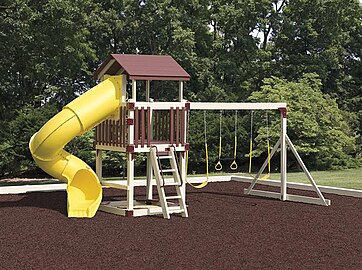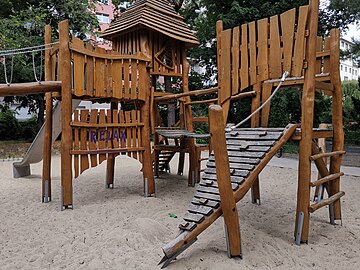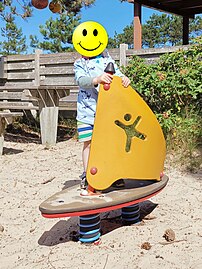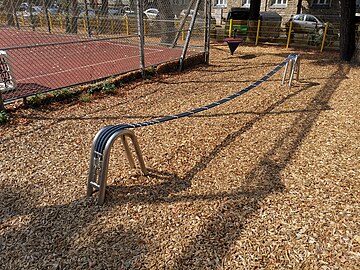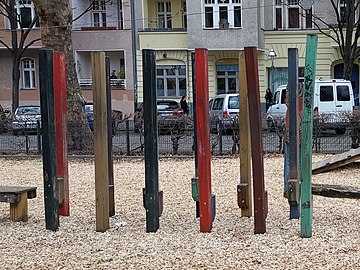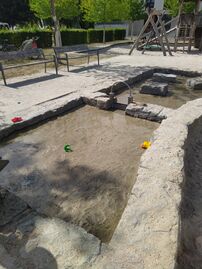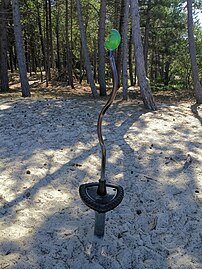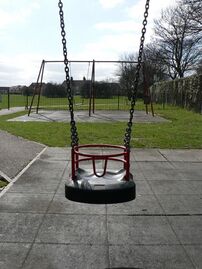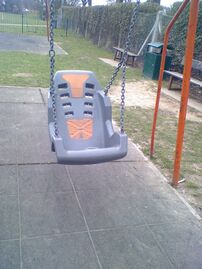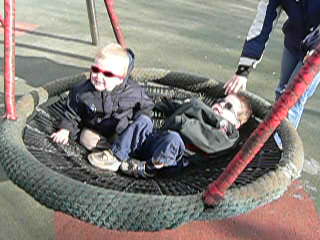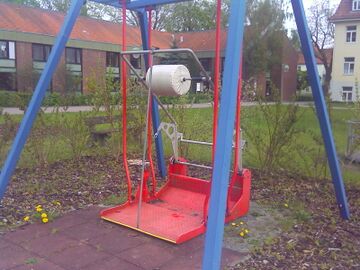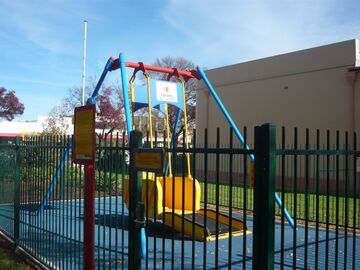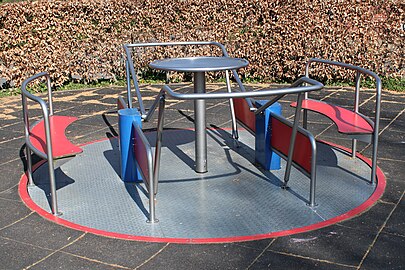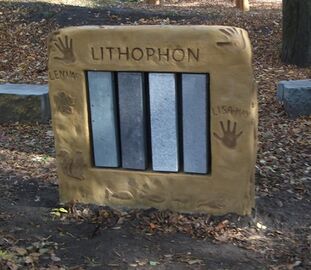Key:playground
 |
| Description |
|---|
| Playground equipment. |
| Group: leisure |
| Used on these elements |
| Documented values: 20 |
| Useful combination |
|
| Status: approved |
| Tools for this tag |
|
The key playground=* describes devices and installations on a playground. It should be tagged to separate objects within the area of a playground leisure=playground.
If a play equipment takes up the whole space of the playground's area leisure=playground, then tag it on the playground area itself with this key.
This key may also be used for play equipment that is not part of a playground, for example a sandpit belonging to a café.
Values
Each item of play equipment is tagged as a node, way or area depending on its shape and size, using the playground key and one of the following values. Some other keys are available for special equipment.
| Key | Value | Element | Comment | Photo | ||
|---|---|---|---|---|---|---|
Classic stationary installations | ||||||
| playground | slide | A smooth, sloped downward surface on which children can slide down. | 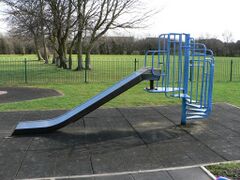 | |||
| playground | seesaw | A long, narrow board supported by a single pivot point, most commonly located at the midpoint between both ends; as one end goes up, the other goes down. Also known as a teeter-totter or teeterboard. | 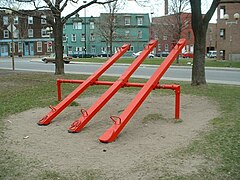 | |||
| playground | rotating_seesaw | A playground device that combines a rotating motion with a seesaw function. Designed for multiple children, who can hold onto handles and gain momentum by rocking and spinning. This device has 3-4 arms with grips, allowing children to both rotate and seesaw. | 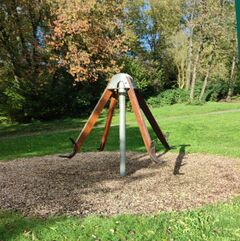 | |||
| playground | springy | A seat on a helical spring (spring rider, spring rocker, springy horse, springy cow, ...) | 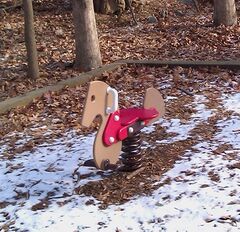 | |||
| playground | structure | Complex installation of connected playground devices comprising platforms, towers, bridges, to which further climbing/slide/swing devices can be attached to. Consider playground=structure as an outline containing other parts that together form the whole structure and can be mapped separately. See also the next section of this table for devices that are often part of structures. |  | |||
Parts of playground structures | ||||||
| playground | bridge | An unspecified bridge, usually a transition between other parts of a structure. For wobbly bridges use playground=wobble_bridge. Bouncing rubber belt bridges (usually stand alone devices) can be mapped with playground=belt_bridge. |  | |||
| playground | wobble_bridge | A simple suspension bridge whose deck or walking elements are suspended merely by cables or similar attached at the ends or top of the bridge and therefore wobbles or swings when moving on it. |  | |||
| playground | platform | A platform, raised level or even a tower, often with railing elements, and often with other playing or climbing devices on the sides or connected bridges. Is often part of a playground=structure that can be mapped separately as an outline containing all parts that together form the structure. |  | |||
| playground | steps | A stairway to get onto a platform or structure. Note: This value is intended for steps that are part of the playground equipment/to reach playground structures and devices. They don't have a function for general traffic. Steps that are part of the regular way network should be mapped as usual. |  | |||
| playground | ladder | A ladder to climb onto a platform or structure. Note: This value is intended for ladders that are part of the playground equipment/to reach playground structures and devices. They don't have a function for general traffic. Ladders that are part of the regular way network should be mapped as usual. | 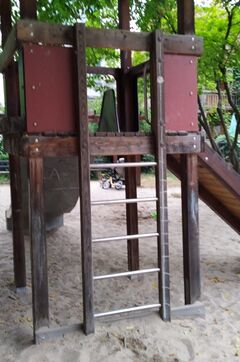 | |||
Swing devices | ||||||
| playground | swing | A swing or swing-set. For baby-friendly swings, e.g. bucket swings, use playground=baby_swing (or problematic baby=yes/no) | 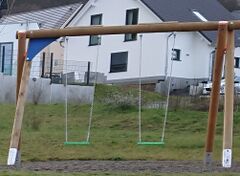 | |||
| playground | baby_swing | A swing or swing-set designed especially for babies (i.e. swings with a bucket shape with holes for the child's legs, or a half-bucket shape and a safety belt, that is intended to reduce the likelihood of a very young child from falling out). Alternative tagging designed to avoid pitfalls with playground=swing + baby=yes |  | |||
| playground | basketswing | Basketswing (also known as nest swing) |  | |||
| playground | tire_swing | Tire swing |  | |||
| playground | rope_swing | A swing element (usually a big rope) attached with chains or cables, on which usually several children can swing together at the same time. Hardly reminds of conventional swings due to the way it works, and therefore uses its own value. |  | |||
Balance devices | ||||||
| playground | agility_trail | A series of thoughtfully designed structures and challenges that encourage kids to climb, balance, jump, and swing their way through. A mix of balance beams, climbing walls, monkey bars or wobbly bridges — all strategically placed to create a fun and engaging adventure |  | |||
| playground | balancebeam | Balance beam in playground shape, often close to the ground |  | |||
| playground | rope_traverse | A rope (or several tied together), tightrope or slackline to walk across while keeping balance. May also have rope(s) or similar to hold on to (use handrail=yes/no to specify this). |  | |||
| playground | stepping_stone | Shifted stones or blocks with a distance between each other, for hopping or stepping from one to the next. See also fitness_station=stepping_stone, if the stepping stones are part of a leisure=fitness_station. |  | |||
| playground | stepping_post | Shifted posts or poles with stepping elements with a distance between each other, for hopping or stepping from one to the next. |  | |||
Climbing devices | ||||||
| playground | climbingframe | Climbing frame, also known as jungle gym, also as rope spider. |  | |||
| playground | climbingwall | Children's version of a climbingwall – for all ages see sport=climbing. | 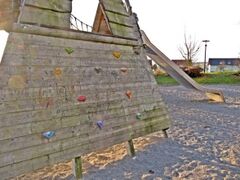 | |||
| playground | climbing_slope | A sloped climbing plane, often with handholds or tethers and often part of a structure to reach a higher level. |  | |||
| playground | climbing_pole | A pole to climb up or slide down. For climbing poles that are part of a leisure=fitness_station, see fitness_station=climbing_pole. |  | |||
| playground | monkey_bars | Horizontal bars or hoops above head height to hang from by one's hands and move over hand over hand. For monkey bars that are part of a leisure=fitness_station, see fitness_station=horizontal_ladder. | 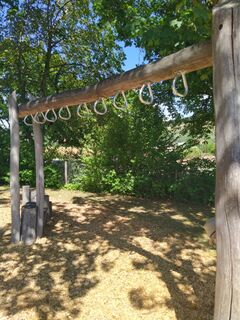 | |||
Rotating devices | ||||||
| playground | roundabout | Roundabout, also known as merry-go-round | 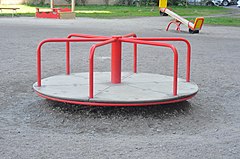 | |||
| playground | basketrotator | A basket rotating around a pole (Basket Rotator, Basket Spinner). |  | |||
| playground | aerialrotator | Aerialrotator | 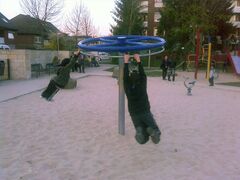 | |||
| playground | spinner | A rotating device that, in contrast to a playground=roundabout, is very small, mostly only a small footboard or seat on a stick for one child. | 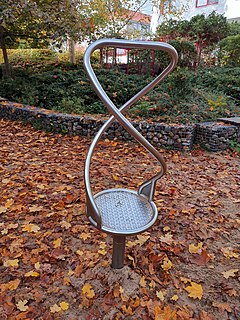 | |||
| playground | spinning_disc | A simple rotating disc. In contrast to a playground=roundabout, there are no add-ons to sit or hold on to. The disc can also be slightly curved - but as soon as it takes a bowl-like shape so that you can find a hold on the sides and perform stronger spinning movements, choose playground=spinner_bowl. |  | |||
| playground | spinning_circle | Spinning circle – a non-electric version of a treadmill (a slanted ring for turning, running and balancing, suitable for several children) | 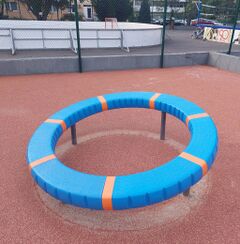 | |||
| playground | spinner_bowl | A spinning, usually tilted bowl. Can be suitable for one or more people. In contrast to a playground=spinning_disc, there is a significant curvature, which allows stronger centrifugal forces and spinning movements. | 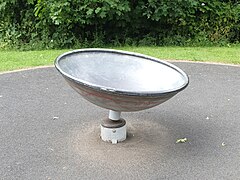 | |||
Sand play devices | ||||||
| playground | sandpit | Sandbox in some regions |  | |||
| playground | chute | A sloped chute or tube, mostly to transport sand by gravity from a higher to a lower place. |  | |||
| playground | sieve | A sieve, allowing to separate fine-grained sand from gravel (in a playground setting typically not finer separated than that). | 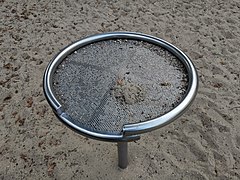 | |||
| playground | sand_wheel | A small wheel that turns when sand falls onto it. Often combined with a chute directly above. |  | |||
| playground | sand_seesaw | A channel or board on a pivot that can either route sand in two different directions, or allows to dump all accumulated sand in a chute-like manner when pivoted (when initially horizontal). | 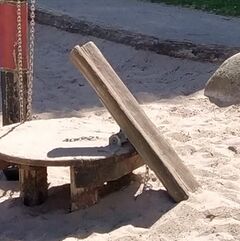 | |||
| playground | sand_pulley | A small bucket or similar device holding sand (also common are sections of tire) that can be moved to another place. Typically either horizontally or vertically; may be mounted on a swivel to give a little more movement range. Often part of structures where it then allows to transport sand to other sand play devices mounted on the structure. |  | |||
| playground | excavator | A small play excavator, allowing to move sand (or that rounded fine gravel) around a bit. Always fixed in place. Usually unpowered as just a series of metal linkages controlling the excavator bucket. For bigger, usually fenced off excavators with a fee=yes consider using attraction=*. | 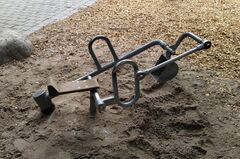 | |||
Water devices | ||||||
| playground | splash_pad | Area with ground nozzles or other water features that spray water upwards out of the splash pad's raindeck. Also known as "spray pool". |  | |||
| playground | pump |
A water source to play with. Often this is an actual pump with handle (consider also adding man_made=water_well + pump=manual), but may also have different forms, such as a water wheel lifting water from a reservoir, or a button that can be pressed for water to flow for a limited time. For water flowing continuously or without interaction, use water_sprayer instead. |
 | |||
| playground | water_channel | An inclined channel for water to flow towards other devices. Typically raised so that multiple channels in series route water from a pump to ground level. For water channels in the ground, resembling natural streams, use water_stream instead. |  | |||
| playground | water_stream | A meandering stream of water resembling a natural water stream and looking a tad less artificial. Often enclosed in an artificial bed of stones. | 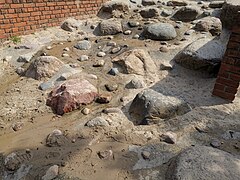 | |||
| playground | water_seesaw | A seesaw-like water channel for either diverting water to two different places, or for automatically tilting and emptying when full. | 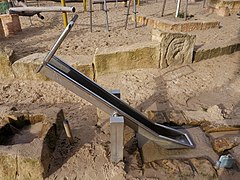 | |||
| playground | water_basin | A pool where water gathers, inviting either to run around in or combine it with sand to mud (also known as "mud table"). May have exits to other channels or even a drain in the bottom (sometimes with a plug). |  | |||
| playground | water_barrier | A removable barrier for water that inhibits flow towards other devices, often via an adjacent channel. |  | |||
| playground | archimedes_screw | A screw-like device for lifting water from a lower to a higher elevation. | 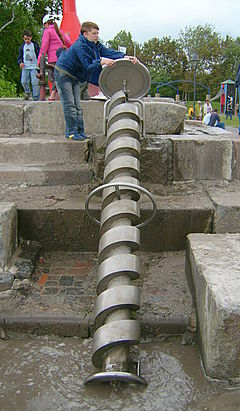 | |||
| playground | water_wheel | A wheel with small buckets or paddles that rotates when water flows into and over it. | 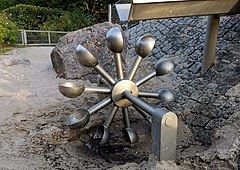 | |||
| playground | water_cannon | A (usually movable) device that allows targeted spraying of water. | 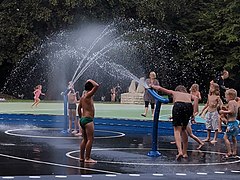 | |||
| playground | water_sprayer | A (often continuously-running) jet of water, often directed upward. This value is intended to map the location of such a water source itself, especially if there are individual water jets or they are particularly significant. To map an entire water play area characterized by multiple water jets, see playground=splash_pad (if there is a large number of water jets within a splash pad, it is usually not necessary to map them individually). | 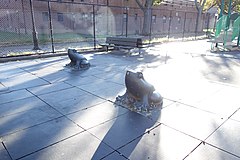 | |||
Activity devices | ||||||
| playground | horizontal_bar | Also known as high bar |  | |||
| playground | parallel_bars | Two or more bars side by side intended to perform gymnastics-like moves. For parallel bars that are part of a distinct leisure=fitness_station, see fitness_station=parallel_bars. If the bars are inclined and therefore intended for sliding moves, use playground=bannister_bars. For vertical bars, playground=climbing_pole may be more appropriate. |  | |||
| playground | bannister_bars | Two or more inclined bars side by side intended to perform sliding moves. See also playground=parallel_bars for non-inclined bars. |  | |||
| playground | hamster_wheel | A large spinning tube to go inside and twist arround, similar to a hamster's wheel. | 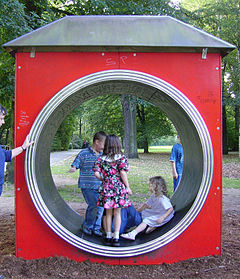 | |||
| playground | activitypanel | Activity panel with various games, such as naughts and crosses (examples) |  | |||
| playground | exercise | Outdoor gym. See alternate suggestion on Proposed features/exercise point and on leisure=fitness_station. |  | |||
Other motion devices | ||||||
| playground | zipwire | See also the "big brother" aerialway=zip_line. Sometimes also called a flying fox | 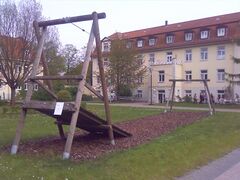 | |||
| playground | trampoline | Trampoline, see also: leisure=trampoline_park | 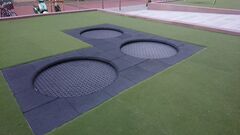 | |||
| playground | cushion | Bouncy cushion (like a flat bouncy castle, without towers), also called jumping pillows |  | |||
| playground | belt_bridge | A tensioned, flat (mostly rubber) band to bounce on. Is very different in its function from classic "bridges" and therefore uses its own value. |  | |||
| playground | spring_board | A board or plane to stand on that is attached to the ground by springs and thus wobbles when standing/moving on it. Can sometimes also be equipped with holding bars to allow to "surf" on it. |  | |||
Other stationary devices | ||||||
| playground | playhouse | Small house or structure that can be entered. Wendyhouse in some regions. If it is more of a shelter (without walls on all sides), use playground=teenshelter. |  | |||
| playground | teenshelter | A small play shelter. If it is more of a house (with walls on all sides), use playground=playhouse. |  | |||
| playground | tunnel_tube | A tunnel for kids to crawl through | 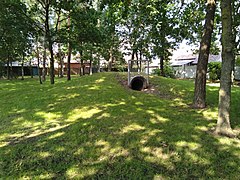 | |||
| playground | speaking_tube | The kids stand at either end and can hear each other‘s voice through the sealed tube (typically tube runs underneath the ground) |  | |||
| playground | hopscotch | A hopscotch court |  | |||
| playground | funnel_ball | A funnel used to play funnel ball | 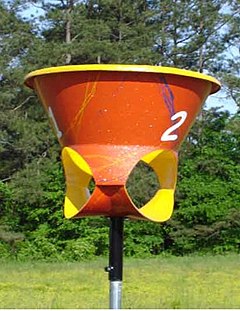 | |||
| playground | ball_pool | A pool full of colored plastic balls. Common at indoor playgrounds. Also known as "ball pit". |  | |||
| playground | ride_on | A fixed installation to sit on. |  | |||
| playground | track | A path on a playground that is intended and equipped as a race track for childrens scooter and bikes. It should have markings, obstacles or objects such as "petrol stations". |  | |||
| playground | marble_run | A rolling ball sculpture where a ball (often a marble) moves through a predefined course just by gravity. |  | |||
| playground | map | Map (often a colorful political map) painted on a paved surface to teach geography |  | |||
| playground | maze | Children have to find a path from start to finish without stepping over the lines. Playground mazes typically don't have physical barriers and are just painted on or use differently coloured materials. Use attraction=maze for mazes with proper walls/hedges. |  | |||
| playground | blackboard | A board to draw on with chalk or something similar. |  | |||
| playground | musical_instrument | A musical instrument or device for making music and sounds. musical_instrument=* could be used to further specify the type of instrument. |  | |||
| playground | table | A table or board to play on or sit at. May include seats/benches or sand toys such as a sieve. Typically not sized for adults. For picnic tables on playgrounds that are also suitable for adults see leisure=picnic_table. |  | |||
| playground | seat | A single seat or bench for children. Typically not sized for adults to sit at. Often part of play houses or similar. |  | |||
| playground | hammock | A hammock, i.e. a spanned/tensioned surface to lie on. For public hammocks in general that are not part of playgrounds resp. intended for this specific target group, there is leisure=hammock in use. |  | |||
| playground | sledding | Small playground hill only – see also sport=toboggan. |  | |||
| playground | youth_bench | A special kind of bench for youth on playground – often with seating at different, age-appropriate seat heights (or for sitting higher with another beam or a bar to put your feet down).
See also bench:type=stand_up.
|
  | |||
Topographical devices | ||||||
| playground | mound | Artificial hills, elevations, waves etc. intentionally designed for play. Sometimes devices like slides or tunnel tubes are placed on or in them. |  | |||
| playground | dome | A half-sphere to climb and slide on. |  | |||
Fallback values for devices, that clearly fit into one equipment category, but do not fit well any of the existing subcategories | ||||||
| playground | balance | An unspecified device to balance on. | ||||
| playground | climbing | An unspecified device to climb on. | ||||
| playground | rotator | An unspecified rotating device. | ||||
| playground | water | An unspecified water device. | ||||
| playground | sand | An unspecified sand play device. | ||||
Other devices that are not in the list | ||||||
| playground | user defined | Playground equipment comes in almost every imaginable shape, design and function. So maybe this list will never be "complete". However, in order to keep it manageable and applicable, this values should not be too specific. On the other hand, even minor changes in the shape of a device can lead to a completely different way of using it. If you come across equipment that you think deserves its own value, you should document it on the playground talk page to share or discuss it with other mappers. So in the future it might be possible to add further discussed values to the list.
See also the TagInfo list of all commonly used values. |
||||
This table is a wiki template with a default description in English. Editable here.
Additional playground equipment is being proposed at Proposed features/Extended playground equipment
Other attractions
Some playground facilities (that might require a fee to enter) offer small attractions like carousels and similar. Those features are described here: attraction=*.
Also, facilities designed for an older public (e.g., giant chess boards) are usually described with leisure=pitch combined with sport=* (e.g., sport=chess).
Useful additional tags
Physical properties
- material=* – E.g. wood, steel, plastic, etc.
- height=* – To specify the height of devices and structures.
- incline=* – Especially to record the inclination of slides and other sloped devices (e.g. playground=climbing_slope).
- capacity=* – To indicate the number of children who can use a device at the same time.
- name=* – If the device has its own specific and commonly known name.
Age specifications
- baby=yes/no – If the equipment is primarily designed for babies. There is also provided_for:infant=yes in use to say the same.
- provided_for:toddler=yes – If the equipment is primarily designed for toddlers approximately between 1 and 3 years of age.
- min_age=* – Minimum age of the user in years.
- max_age=* – Maximum age of the user in years.
Accessibility
- wheelchair=yes/no/limited – If the equipment can be used by wheelchair users.
- walking_disability=yes/no/limited
- sitting_disability=yes/no/limited – If the equipment can be used by those who cannot sit.
- blind=yes/no/limited
- locked=* – To indicate whether a key is required to access the equipment.
- centralkey=* – For standard keys used.
Others
- sensory=* – To indicate which particular sensory qualities a device addresses; e.g. visual, tactile, audible or smell.
Relation between playground equipment and the playground area
To associate the playground area with the playground equipment, simply draw the playground as area and add the equipment as independent objects (nodes, ways or polygons) inside.
Examples
General examples for devices and useful additional tags
-
A
platformwith aladderand aslide. Someswings are also connected to it. -
A steep
slidewith aladderleading up to it. Details like height=3, incline=-56° and material=metal (on the slide) or step_count=8 and material=wood (on the ladder) can be added. -
Larger form of a
spring_board. -
A
rope_traverseconsisting of three smaller, tied ropes. Since there is no railing/tether/rope to hold on to, handrail=no can be added. -
stepping_posts made from material=wood on a playground. -
Two
water_basins with a closablewater_barrierbetween them. -
A rotating stick device, tagged with
spinner. -
A special, non-specific construction for climbing and/or balancing - one of the fallback values
balanceorclimbingmight fit best.
Examples for tagging the accessibility of playground equipment
-
playground=swing
baby=yes or
playground=baby_swing
Standard baby swing - bars are to stop baby escaping, not to provide postural support -
playground=swing
sitting_disability=yes
Swing seat for inclusive play - allows a user with poor balance or posture to be seated on the swing -
playground=basketswing
sitting_disability=yes
Basket/Wave/Hammock swing - note users normally lie down on this as opposed to sitting up on other types of swing -
playground=swing
wheelchair=yes
walking_disability=yes
Swing for wheelchair users or other disabled persons -
playground=musical_instrument
sensory=audible
(sensory=audible can be assumed as default for musical instruments.)
Themes
Playgrounds, their structures and individual devices are often themed, mimicking ships, castles, cars or animals.
playground:theme=* can be used to describe them. Keep the theme to a major category, and any specifics to description=* or name=*, see examples:
| Theme | Image | Tagging |
|---|---|---|
| Ship play structure | 
|
playground:theme=ship
playground=structure |
| Octopus play structure
(popular in Japan) |

|
playground:theme=octopus
playground=structure |
| Castle play structure | 
|
playground:theme=castle
playground=structure |
| Rocket play structure | 
|
playground:theme=rocket
playground=structure |
| Springy horse | 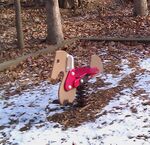
|
playground:theme=horse
playground=springy |
| Springy cow | 
|
playground:theme=cow
playground=springy |
| Spiderweb climbing | 
|
playground:theme=spiderweb
playground=climbingframe |
| Dragon slide | 
|
playground:theme=dragon
playground=slide |
Mapping all objects on one node
Only when the position of the individual objects cannot be mapped yet, the tag in theory can be added to the playground node. Note that this data would not be helpful for mappers improving it and any improvements of this data would require full resurvey. This type of mapping is not popular (1.6% of playground=* keys as of 2017).
